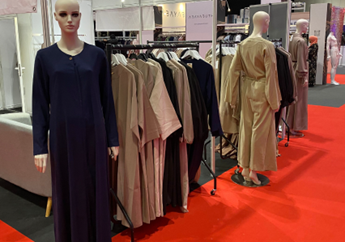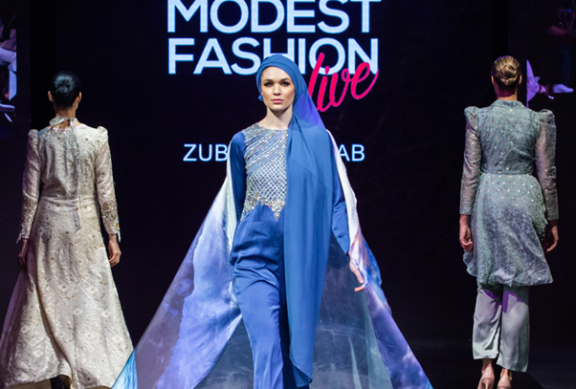
The European market potential for Islamic wear
Europe’s Muslim community is young, growing and has buying power. They are increasingly using social media to find role models and to express their style as well as their religious identity. Fashion more generally is also becoming more inclusive of minorities.
Contents of this page
1. Product description
Many Muslims believe that adult Muslim men and women have a religious duty to dress modestly and according to traditional guidelines. Islamic wear (also known as ‘modest wear’) is influenced by these principles, enabling the wearer to respect Islamic teachings related to modesty (haya). The concept of modesty is interpreted differently in different parts of the world, and within different Muslim communities. Generally speaking, the following applies:
- Muslim men and women should dress simply and with dignity;
- Clothing should not attract attention or be worn to show off;
- Certain parts of the body should be hidden from public view;
- Muslim men should cover the area between the waist and the knees;
- Women should cover their hair and their body between the neck and the ankles; and
- The materials used should not be transparent or be designed to show off the shape of the body.
Some Muslim European women wear a hijab, while others believe that women are not required to wear a hijab or a face covering such as a niqab or burqa. A smaller number of women choose to wear a Niqab. Burqas are only worn by a very small minority. For example, in France (the European Union (EU) country with the largest Muslim community), 1,900 women wore the Burqa in 2011, representing just 0.04% of the French Muslim population.
Traditional Islamic garments
There are 2 types of specifically Islamic clothing: traditional Islamic garments and modest fashion garments. Traditional Islamic wear typically consists of long, loose-fitting garments. Polyester is the most widely used fabric for traditional clothing and special occasions. Modern fashion has adapted traditional Islamic garments and given them a modern and stylish look. There is increasing demand for Islamic clothing made from different materials (including soft, breathable, light-weight and sustainable materials).
Figure 1: The abaya is the most popular type of garment worn by Muslim women in Europe

Source: Forward in Fashion
Women
- Abaya – a robe worn over clothing in public
- Jilbab – a long, loose-fitting outer garment
- Sari – a long piece of cloth that is wrapped and/or draped around the body
- Burqa – an outer garment that fully covers the face and body
- Head coverings:
- Khimar – a headscarf that is draped over the upper body)
- Niqab – a piece of cloth placed over the headscarf
- Hijab – covers the hair and neck
- Dupatta – a long scarf draped loosely around shoulders and face
- Al-amira – close-fitting cap and tube-like scarf
- Under scarves
Men
- Thobe – a long robe
- Ghutra and Egal – a head scarf and rope band
- Bishit – a cloak worn over Thobe
- Shalwar Kameez – combination of loose trousers worn with a long tunic
- Turban – a head covering
Modest fashion wear
Many European Muslim consumers wear ‘Western’ clothes which also meet the requirements of the Muslim dress code, sometimes combining these with traditional garments such as a hijab. These garments include long dresses, maxi skirts, wide-leg trousers and clothes with long sleeves and high necklines. Even though the European climate is less hot than that of the Middle East, loose-fitting clothing is often still preferred as it is regarded as a more modest option.
Tips:
- Ramadan is the peak season for retail sales. Make sure that your sales and production calendars are aligned accordingly.
- Combining Islamic clothing with modern fashion may give you an early-adopter advantage because this combination is becoming more popular.
- Even if your collection is not designed specifically for Muslims, you could still target this group. Many Muslim consumers combine traditional clothing with locally available styles.
2. What makes Europe an interesting market for Islamic fashion?
In 2016, Europe’s Muslim community included about 25.8 million people, or a 4.9% of the total population. That figure had risen from around 19.5 million (or 3.8%) in 2010, driven by high rates of fertility and migration. With medium levels of migration, Europe’s Muslim population is forecast to rise to 57.9 million (11.2%) by 2050. In the United States, by contrast, a 2017 study estimated that there were just 3.45 million Muslims, or 1.1% of the total population.
Source: Pew Research Centre
According to the 2022 State of the Global Islamic Economy Report, targeting the underserved Muslim-minority in Western markets is a top growth area for modest fashion.
Within Europe’s Muslim community, people aged between 15 and 29 are expected to make up about 21% in 2030; this compares to just 16% among non-Muslims. Currently, it is young Muslim millennials (referred to as Generation M) who are driving the ‘modest fashion revolution’. They believe that consumerism and modern fashion do not go against their religious beliefs.
According to Eurostat, in 2021, Europeans spent an average of 4.2% of their total expenditure on clothing and footwear. The post-pandemic peak in total European private consumption occurred in September 2021 (almost reaching pre-pandemic levels). However, consumption has decreased steadily since the first quarter of 2022 before starting to make a recovery. Inflation is expected to have a negative effect on European consumption.
Even though clothes are essential items, most European consumers are able to postpone buying new clothes. The Islamic wear industry will be no exception. A pre-Ramadan 2023 survey of UK Muslims showed that as many as 42% of respondents intended to spend less on EID gifts than in previous years.
Islamic clothing is often bought for special occasions or as a gift during Ramadan
Ramadan is a time when practising Muslims focus on prayer, fasting and reflection. Muslims also mark this special time of the year by wearing their best (new) clothes. Ramadan has evolved from a quiet family time to a month-long marathon of multiple Iftars (meals to mark the end of the daily fast), shopping events and coffee dates with friends, relatives and colleagues. Ramadan ends with the Eid al-Fitr festival – another 3-day festival of shared meals and other social occasions for which everyone wants to look their best.
Traditionally, Muslims buy 1 or 2 new outfits for Ramadan each year. With growing spending power and an increased focus on Ramadan as a month of intense socialising, some Muslim consumers may even purchase a whole new wardrobe.
It is also common for people to buy new clothes for their family members, including children. According to a 2017 report published by Islamic brand consultants Ogilvy Noor, Ramadan gift-giving is a ‘core ritual for Eid’. The report notes that 50% of women between the ages of 35-44 choose to buy fashion items as Eid gifts.
Western brands have recognised that Ramadan is big business and many have developed special Ramadan collections. This includes both luxury and mass-market fast-fashion brands. A 2022 UK survey of Muslim consumers found that 58% planned to start shopping for Ramadan 1 month in advance.
Tips:
- Focus on high-quality but affordable modest fashion with simpler styling that appeals to the younger generation.
- For B2C business, tap into the modest wear social media revolution by optimising your social media presence (Facebook, Tik Tok, Instagram).
- Show your Islamic heritage as part of your company/brand image.
3. Which European countries offer the most opportunities for Islamic fashion?
The largest Muslim communities in Europe are found in France, Germany, Italy, Spain and the Netherlands. The size of the Muslim community is expected to increase in both relative and absolute terms in the years to come.
Source: Pew Research Center (2017) for 2016 estimates; Pew Research Center (2011) for 2030 projections
Other markets to watch are Austria, Sweden and Belgium, even though these countries have smaller Muslim communities in absolute terms. They remain attractive because the Muslim population is expected to reach around 10% share of the total population by 2030:
- Austria (799,000 / 9.3%)
- Sweden (993,000 / 9.9%)
- Belgium (1,149,000 / 10.2%)
Legal restrictions
Most Muslims in Western Europe are members of immigrant communities and in recent years there have been many debates on whether certain types of Islamic wear should be allowed to be worn in public. Some non-Muslims see these pieces of clothing as symbolising the oppression of women. These debates are often related to the integration of Muslims into Western Europe’s largely secular societies. Legislation has been put in place in many European countries restricting the use of the burqa, niqab, hijab and burkini. Additional legislation is expected.
France is the European country with the strictest laws regarding Islamic wear. This particularly affects the hijab which was worn by 31% of French Muslim women in 2019, according to Statista. Only 6 countries in the EU impose no restrictions on either the hijab or the niqab: Croatia, Cyprus, Greece, Poland, Portugal and Romania.
According to a survey among non-Muslims, those in the Netherlands are the most supportive of at least some restrictions on religious clothing, followed by France and Germany. In these countries 18%, 23% and 24% of respondents felt that Muslim women should be allowed to wear any religious clothing they like. In Sweden 49% said they believed this.
Tips:
- Focus on Islamic clothing that does not cover the face.
- Consider specialising in a niche category that successfully merges Islamic and Western styles. For example streetwear, performance wear or Scandinavian-inspired minimalist fashion. Examples of brands include Moomen, Syndeed, PUMA, EMIR. Examples of influencers include Mohamed Sharif, Moxeb and Saeedah Haque.
- Study the country-specific trends and legislation before entering the market.
4. Which trends offer opportunities or pose threats on the European Islamic fashion market?
In the apparel industry, the hijab has been featured in fashion campaigns as a symbol of strength and empowerment. This is due to the rising popularity of hijabi women influencers, celebrities and sportswomen who are showing that it is possible to ‘wear the veil’ and be fashionable.
With over 5.2 million posts on Instagram, the hashtag #modestfashion shows the extent to which the modest wear revolution is driven by social media. Global searches for ‘modest clothing’ in English on the Google search website increased by 270% between March 2016 and March 2023. A 2022 survey by the Muslim Ad Network found that 93% of the businesses who responded use Facebook Ads as a channel to advertise to Muslims online. Other channels included Twitter Ads, LinkedIn Ads, Instagram Ads and Tik Tok Ads.
As a result, the marketing of Islamic clothing is no longer confined to brands targeting wealthy Muslims with fashion lines for Ramadan or other festivities. The market is becoming more mainstream. Brands in both the fashion and sportswear segments have established permanent modest wear collections which they promote via social media.
Modest wear influencers are increasingly curating collections and adapting mainstream fashion brands, thus broadening the scope of what modest fashion can be.
Tips:
- Curate modest wear collections for your exhibits from your main fashion collections.
- Take inspiration from modest fashion bloggers and influencers who curate from mainstream fashion. Lists of top bloggers can be found on the internet. For example: Modest Fashion Influencers You Need to Follow and Top 10 Modest Fashion Influencers.
- Get inspiration from key e-commerce sites focused on modest wear for the EU market. You will find traditional Islamic wear on Islamitischekleding and Shukr, and more modern modest wear on Modanisa.
Figure 4: The Muslim Shopping Festival in London is 1 of the largest fashion and lifestyle events for European Muslims

Source: The Muslim Shopping Festival
Sustainable fashion could be the future of Islamic wear
Sustainable Islamic wear is still a niche. However, the market is expected to grow because large mainstream brands and retailers increasingly sell modest styles and tend to have stricter sustainable requirements.
Many Islamic values involve social responsibility. The concept of sustainability is similar to the Islamic idea of ‘stewardship of the Earth’, implying that people have a duty to preserve the natural environment. According to Shelina Janmohamed, author of the book ‘Generation M’, young Muslim millennials are focused on tayyab, which means ‘ethical and wholesome’ and they want the entire supply chain of production and consumption to have integrity.
Whilst Islamic traditional garments tend to be made from lightweight polyester fabric, other, more sustainable, materials are starting to be introduced into modern modest collections, such as modal/bamboo, linen, recycled polyester and organic cotton.
Germany and France (the largest 2 markets in absolute terms) are countries with stricter and/or increasing sustainability and circularity requirements, driven by national legislation and policies. This creates opportunities for higher quality and more sustainable products.
Tips:
- Focus on both modern modest wear and sustainable materials to gain a competitive advantage. For more information on sustainable materials, read the CBI report Exporting products that contain sustainable materials.
- Check out more sustainable Islamic wear brands for materials inspiration. Examples are AAB or NEA (Winner of most sustainable modest wear brand 2022).
- Visit Islamic wear exhibitions and trade fairs. For example, the London Muslim Shopping Festival and Modest Fashion Week events, including the Paris Modest Fashion Week. This can help identify sustainable Islamic wear brands
Above-average fertility rates create opportunities for kids wear
By 2025-2030, the average fertility rate for Muslim women in Europe is expected to be 2.0 children per woman. In contrast, the average fertility rate for non-Muslim women is projected to be just 1.6 children per woman.
In 2022, the following countries had a birth rate that was higher than the EU average of 9.5 per 1000 people: France, Belgium, the Netherlands, Sweden, Denmark and Norway. France and the Netherlands also have the largest and fifth-largest Muslim communities by population in Europe, respectively.
In Scandinavia, the high birth rate can be in part attributed to public policies that encourage working women to have children. These policies include generous maternal/paternal leave benefits, parent/child sick day benefits, incentives to have several children in quick succession and excellent state-funded childcare services and schools. By contrast, Germany’s policies encourage women to leave the workforce to receive benefits.
Even though clothing worn by pre-adolescent Muslim children may not differ significantly from that worn by non-Muslim children, many Muslim parents will identify with the values presented by Muslim brands.
A 2022 survey by the Muslim Ad Network found that 71% of respondents were ‘keener to buy from Muslim brands’. Items manufactured in a predominantly Muslim country may therefore also have more appeal than clothes manufactured elsewhere. These manufacturers could gain a further advantage by demonstrating ethical and sustainable production practices.
Tips:
- Target countries such as France and the Netherlands. They are among Europe’s largest clothing and babywear importers, have high fertility rates and large Muslim communities.
- Sustainable and organic kids wear is a strong segment in mainstream European fashion. When targeted at both pre-adolescent and adolescent Muslim children, it represents a niche market with high potential for first movers.
- If you are a supplier in a predominantly Muslim country, make sure that your branding and website includes a focus on the country of origin and on Muslim values.
Increased participation of Muslim women in sport
According to Eurostat, in 2019, 44.3% of Europeans aged 15 or higher engaged in recreational physical or fitness activities at least once per week. Scandinavian countries had the highest participation rates (Norway 84.2%, Denmark 75.8%, Sweden 75.3%) followed by Germany (67.3%). The EU figure drops only slightly to 42% for the female population. In Sweden and Denmark, female participation rates are higher than male participation rates.
Research shows that sports activity levels are lowest among women who practise Islam. This can be explained by low levels of inclusivity both within society and in sport. Barriers to participation include:
- Incompatibility with traditional clothing
- Fasting during Ramadan
- A lack of women-only spaces
- Fear of harassment while wearing a head covering during sport
- Designated times of prayer may interfere with sporting schedules
There is increased acceptance of Islamic clothing within professional sport. For example, in 2012, FIFA lifted its 2007 ban on the hijab. In addition, a growing number of Muslim professional sportswomen serve as role models who inspire young European Muslim women. In a survey by the Muslimah Sports Association (PDF), 97% of the UK Muslim women who responded said they wanted to increase their current participation in sports.
The 2022 State of the Global Islamic Economy Report highlighted sports clothing as a top growth area for clothing. Global sports brands are helping to break down barriers further by designing sports and activewear specifically for Muslim women. Examples include Nike’s ‘Pro Hijab’ and ‘Modesty swimsuit’. Adidas and Puma also have permanent modest activewear ranges.
Alvina is a Turkish apparel company that specialises in the design, production and sale of women’s clothing and accessories in modest styles, including sportswear such as tracksuits, tunics and swimwear. Over 1,000 people are employed in production. Located in İzmir, the centre covers a closed area of 12,500 square meters.
Tips:
- Investigate country-specific requirements. Every European country has different general consumer preferences.
- Prioritise comfort and fit when manufacturing Islamic sportswear.
- Visit the various Muslim fairs, such as the London Muslim Shopping Festival in London, to learn about the market and consumer buying behaviour.
Giovanni Beatrice and Frans Tilstra from FT Journalistiek carried out this study on behalf of CBI.
Please review our market information disclaimer.
Search
Enter search terms to find market research
